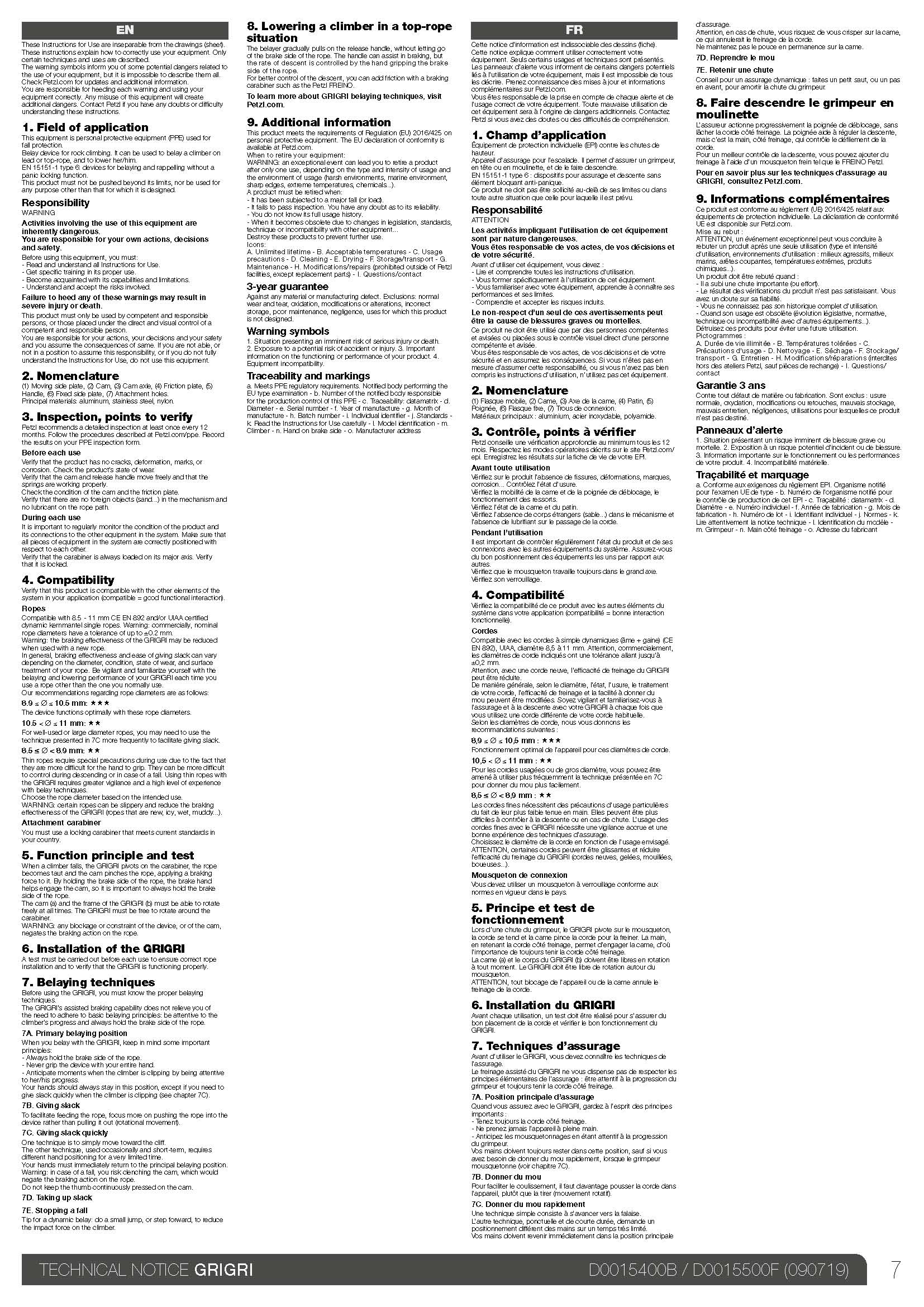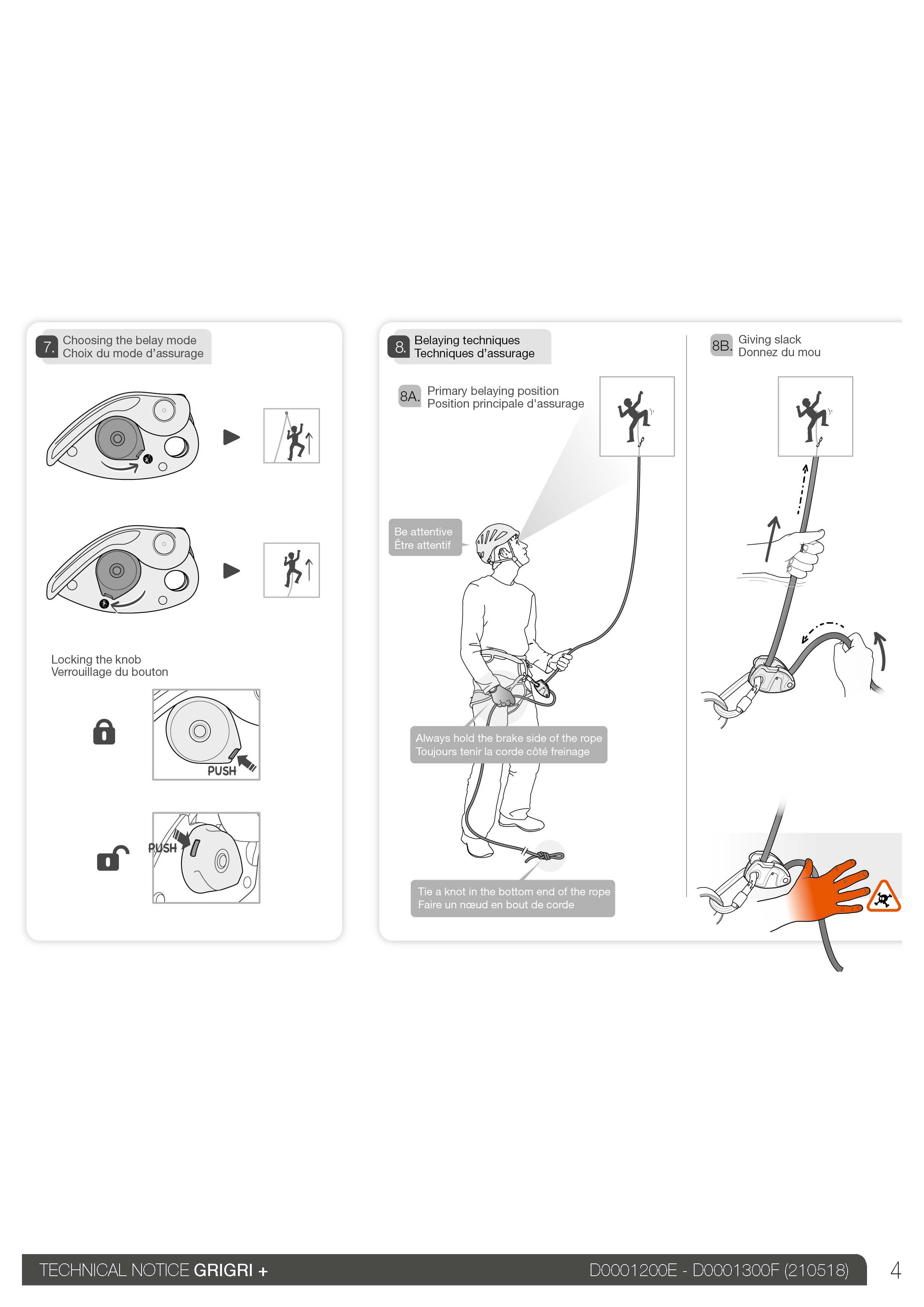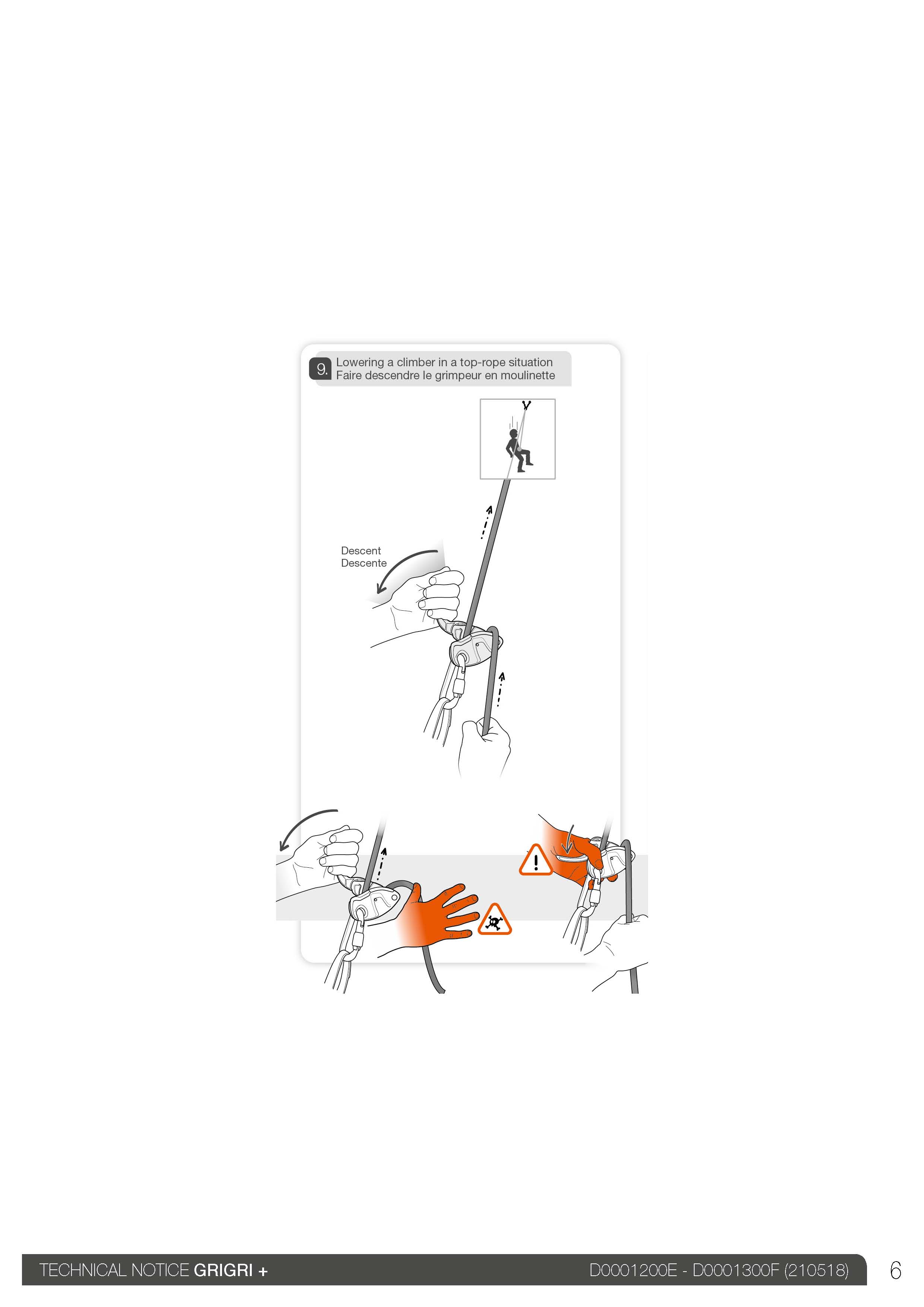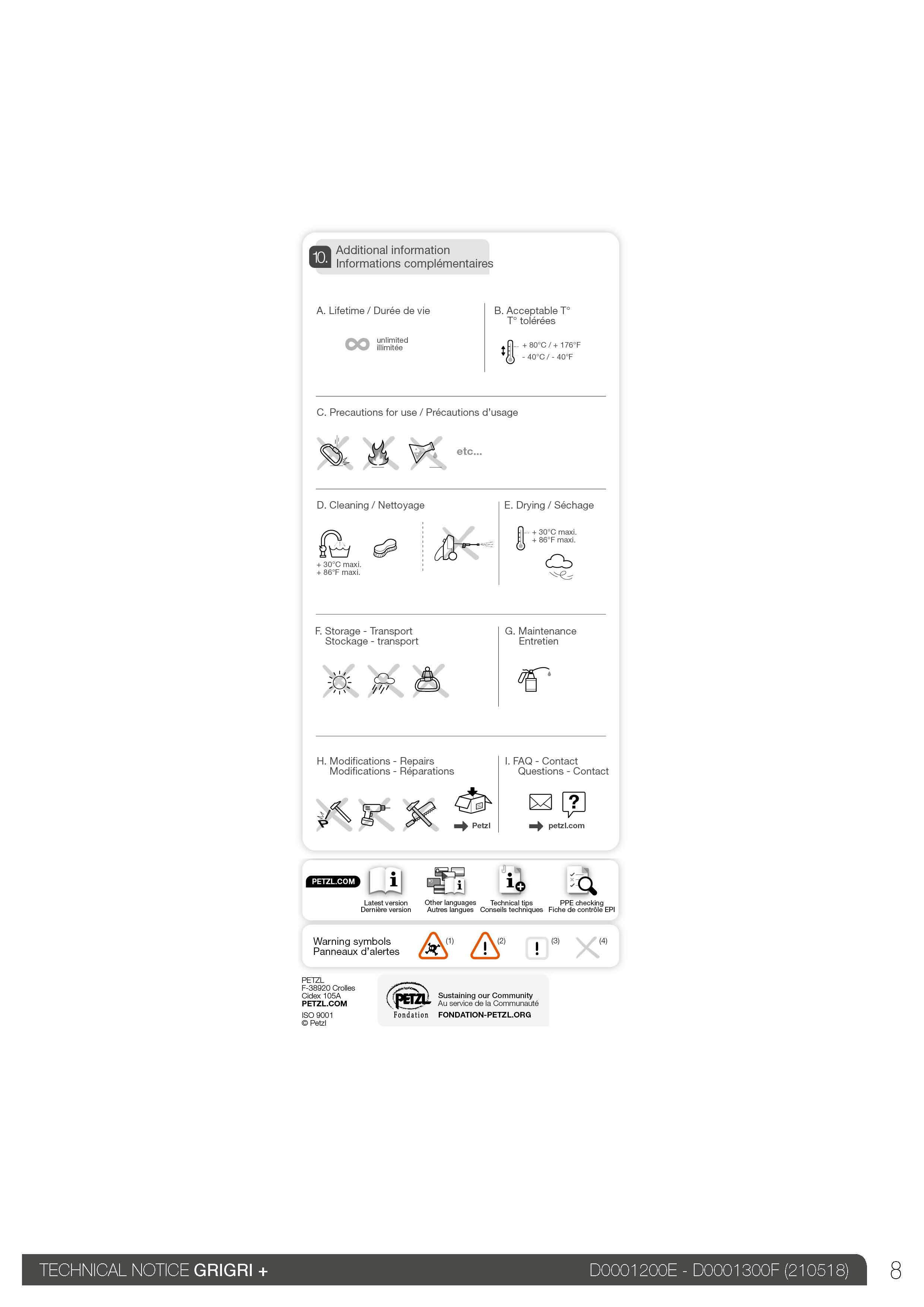Overview
Petzl’s naming confuses the chronology. The sequence is as follows:
- Grigri (my Version A)
- Grigri 2
- Grigri +
- Grigri (my Version B, unofficially a.k.a. Grigri 3)
[ Top
| Grigri 2
| Version B
| Grigri +
| Return to Lever Box Belay
]
Grigri, Version A
(#626, 1622, 2668)
Technical Details
I acquired one Petzl Grigri from Inner Mountain Outfitters in 1992. I obtained a second from Charles Denning in 2009 and then in 2024 attached a GG Modifier to convert it into a Self-belay Device For Solo Climbing. I acquired another in 2017 as part of Bob Thrun’s collection.
My Grigri is 118 mm. tall, 68 mm. wide, 43 mm.
thick, and weighs 225 g.
The Grigri consists of a spring-loaded cam assembly mounted
between a back plate and a swinging front plate. The two plates
are stamped from 3.1 mm. aluminum alloy and then anodized.
The plates are shaped roughly like a mirror-image "D."
The two plates are loosely riveted together near the top, with
a 16.5 mm. stamped stainless steel anvil that serves as spacer
between the two. The front plate can rotate about 135° clockwise
with respect to the rear plate and spacer, allowing one to open
the Grigri for rigging. The two plates have inward dog-leg bends
near the bottom, where 14.4 mm. attachment holes are punched
through the sloping portion of the dog-leg. The front plate has
a slot for capturing the head of the cam axle, and an arch to
the right of the slot to provide support. The upper left half
of the front plate is bent forward to provide a 10.4 mm. diameter
curved surface for the rope to run over. A plastic spine fills
the right side of the device between the plates.
The cam is cast from stainless steel. The cam can rotate about
135° clockwise with respect to the rear plate, but
a strong spring opposes this rotation. If the belayed climber
falls, the cam rotates clockwise, and the top surface
of the cam squeezes the rope against the anvil. A spring-loaded
plastic handle on the rear of cam gives the belayer more leverage
to release the cam.
The front plate is stamped with "GRIGRI" and rigging
illustrations. The spine is stamped with "0592A" and
printed with the Petzl logo. The cam assembly has a rigging illustration consisting of a roped climber inside an
arrow cast into it. The rear of the cam assembly has "91" inside
a star-burst that might indicate the month the cam was made. The
handle has the Petzl logo molded into both sides. The rear plate
is stamped with "ONLY FOR ROPE1UIAA MIN Ø10 MAX Ø11"
(the "1" after "ROPE" has a circle around
it), "MADE IN FRANCE-PATENTED." and rigging
illustrations consisting of a hand holding a rope and a climber
trailing a rope. It also has a warning sticker attached with the
usual kinds of liability warnings that the American lawyers who
seek to destroy our country make us suffer with. Amusingly, the
warning is repeated in French - somehow I thought the French had
more sense, my mistake.
The Grigri is a popular belay device among sport climbers,
and since it provides a hands-off belay, it is required in some
climbing gyms where the competence of the clientele is questioned
by the liability insurance companies. In these situations, the
Grigri is a good choice. It is also popular on big walls where
the belayer is snoozing on the ’ledge groovin’ on tunes while
the leader is spending hours on an aid lead. Although its nice
to know that the device will work if I peal, even if my second
is inattentive, I don't choose my second that way.
Having said that the Grigri is a fine device, let me tell you
a story.
One day, my friend Bruce Smith (of On Rope 1) called me over
to his sales area and said,
"Gary, I hear you don't like the Grigri."
"Yes."
"In fact, I heard you say that it ______."
"Not exactly, but I'll go along with that, for my purposes."
"Tell me one thing - just one thing - wrong with
the Grigri!"
"You can't use it to rappel on doubled rope."
"OK, tell me another."
"Well, since I'm now carrying another device to let me
rappel on double rope, it weighs more than nothing and is bigger
than nothing."
Actually, you can rappel on double ropes, but it is a nuisance (Bruce knows how, he just didn't
think of how to do it fast enough to answer me quickly). The point
is, the device is fine for some things, but for others, other
devices may be more appropriate. At that time I was climbing more,
including aid pitches where we would end up rappelling the lead
and haul lines, and I needed a convenient double rope device.
This wasn't normal sport climbing, and for what I was doing, the
Grigri wasn't it.
And now, more facts. The Grigri has a cam that locks up when
the climber falls. Releasing the cam involves squeezing the Grigri.
Its a bit tiring, but if your hand lets go, the fallen climber
stops. Very nice. There is also a handle to give the belayer more
leverage (it’s on the other side, and can't be seen in the photos).
My opinion is that the handle gives too much leverage, making
it too easy to drop the leader.
[ Top
| Version A
| Grigri +
| Version B
| Return to Lever Box Belay
]
Grigri 2
(#1727)
Technical Details
I acquired my Petzl Grigri 2 from gotyourgear.com in 2011.
My Petzl Grigri 2 is 57 mm. long, 101 mm. wide, 44 mm. high, and weighs 171 g.
The Grigri 2 is a smaller version of the original Grigri. I will background the Grigri description in gray, and indicate the changes in black:
The Grigri 2 consists of a spring-loaded cam assembly mounted
between a back plate and a swinging front plate. The two plates
are stamped from 2.4 mm. aluminum alloy and then anodized.
The plates are shaped roughly like a avocado.
The two plates are loosely riveted together near the top, with
a 13.5 mm. stamped stainless steel anvil that serves as spacer
between the two. The front plate can rotate about 135° clockwise
with respect to the rear plate and spacer, allowing one to open
the Grigri for rigging. The two plates have inward bends near the bottom, where 16.9 × 15.0 subtriangular attachment holes are punched
through the sloping portion of the plates. The front plate has
a slot for capturing the head of the cam axle, and an arch to
the right of the slot to provide support. The upper left half
of the front plate is bent forward to provide an 11.8 mm. diameter
curved surface for the rope to run over. A plastic spine fills
the right side of the device between the plates. A beveled plastic fairing is screwed to the back plate.
The cam is cast from stainless steel. The cam can rotate about
75° clockwise with respect to the rear plate, but
a strong spring opposes this rotation. If the belayed climber
falls, the cam rotates clockwise, and the top surface
of the cam squeezes the rope against the anvil. A spring-loaded
plastic handle on the rear of cam gives the belayer more leverage
to release the cam.
The front plate is stamped with "GRIGRI," a book-with-an-"i" icon, and rigging
illustrations. The spine is printed with the Petzl logo. The cam assembly has
the Petzl logo and a rigging illustration consisting of a roped climber inside an
arrow cast into it. The
handle has "made in France" molded into the rear side. The rear plate
is printed with "11193FR9051;" an inventory control code, a book-with-an-"i" icon; a divided line segment with the division marks labeled below with "Ø10 MAX Ø11 8.9," "9.4," "10.3," and "11mm"
and the three segments labeled above with "**," "***," and "**," respectively; "ONLY FOR ROPE1UIAA "(the "1" after "ROPE" has a circle around
it)’ "WARNING : PROPER TRAINING IS ESSENTIAL BEFORE USE;" and "prEN15151-1 UIAA." The fairing has the Petzl logo and "Patented" molded into it.
The very early GriGri 2s were recalled for a manufacturing defect. Mine is one of the first ones that became available after the recall.
I like the size reduction. The Grigri 2 is still a complex device that works well in some situations, but I still prefer the K.I.S.S. principle for general use.
[ Top
| Version A
| Grigri 2
| Grigri +
| Return to Lever Box Belay
]
Grigri, Version B
(a.k.a. Grigri 3)
(#2743)
Technical Details
I acquired this Grigri from Omni Pro Gear in 2019. I acquired a second from Amazon.com in 2024 and attached a GG Modifier to convert it into a Self-belay Device For Solo Climbing.
Mine is 60 mm. long, 103 mm. wide, 44 mm. high, and weighs 177 g.
This version is a later version of the Grigri 2. Petzl calls it a Grigri, but some others use the more sensible name Grigri 3. I will background the Grigri 2 description in gray and indicate the changes in black:
The Grigri 3 consists of a spring-loaded cam assembly mounted
between a back plate and a swinging front plate. The two plates
are stamped from 2.4 mm. aluminum alloy and then anodized.
The plates are shaped roughly like a avocado.
The two plates are loosely riveted together near the top, with
a 14.5 mm. stamped stainless steel anvil that serves as spacer
between the two. The front plate can rotate about 135° clockwise
with respect to the rear plate and spacer, allowing one to open
the Grigri for rigging. The two plates have inward bends near the bottom, where 17.7 × 15.3 subtriangular attachment holes are punched
through the sloping portion of the plates. The hole on the front plate is surrounded by a border that is stamped outward. The front plate has
a slot for capturing the head of the cam axle, and an arch to
the right of the slot to provide support. The upper left half
of the front plate is bent forward to provide a 10.6 mm. diameter
curved surface for the rope to run over. A plastic spine fills
the right side of the device between the plates. A beveled plastic fairing is screwed to the back plate.
The cam is cast from stainless steel. The cam can rotate about 75° clockwise with respect to the rear plate, but
a strong spring opposes this rotation. If the belayed climber
falls, the cam rotates clockwise, and the top surface
of the cam squeezes the rope against the anvil. A spring-loaded
plastic handle on the rear of cam gives the belayer more leverage
to release the cam.
The front plate is stamped with "GRIGRI" and rigging
illustrations. The spine is printed with the Petzl logo. The cam assembly has
the Petzl logo and a rigging illustration consisting of a roped climber inside an
arrow cast into it. The
handle has "made in France" molded into the rear side. The rear plate
is printed with "Petzl," "F-38920," and "Crolles Cidex 105A;" "19C0183113482;" a scanner code; a divided line segment with the division marks labeled below with "Ø10," "8.9," "9.4, "10.5, and 11mm"
and the three segments labeled above with "**," "***," and "**," respectively; "CE" and "0082;," a book-with-an-"i" icon; "FOR ROPE1UIAA;" and "EN15151-1 UIAA." The fairing has the Petzl logo and "Patented" molded into it.
The Grigri2 and 3 are quite similar, and I don't notice any substantial difference in how the two function.
[ Top
| Version A
| Grigri 2
| Version B
| Return to Lever Box Belay
]
Grigri +
(#2693)
Technical Details
I acquired my Grigri+ from On Rope 1 in 2017.
My Grigri+ is 60 mm. long, 95 mm. wide, 43 mm. high, and weighs 209 g.
The Grigri + is similar to the Grigri 2 and Grigri3. I will background the Grigri 2 description in gray, and indicate the changes for the Grigri + in black:
The Grigri + consists of a spring-loaded cam assembly mounted
between a back plate and a swinging front plate. The rear plate is stamped from 2.4 mm. aluminum alloy and then anodized.
The front plate is forger and/or milled from aluminum alloy and also anodized. The plates are shaped roughly like a avocado.
The two plates are loosely riveted together near the top, with
a 15.5 mm. stamped stainless steel anvil that serves as spacer
between the two. The front plate can rotate about 135° clockwise
with respect to the rear plate and spacer, allowing one to open
the Grigri for rigging. The two plates have inward bends near the bottom, where 17.8 × 15.8 subtriangular attachment holes pass through the sloping portion of the plates. The inside of the front plate has a milled channel to pass the head of the cam axle. A 1 mm. stamped stainless steel piece riveted to the front plate provides a lip to engage a notch in the cam axle when the front plate is closed. This stainless steel piece extends around to the front of the front plate, providing a 7.2 mm. diameter
curved surface for the rope to run over. A plastic spine fills
the right side of the device between the plates. A plastic cover attached behind the rear plate covers the cam spring mechanism. This cover can be rotated and latched into one of two positions.
The cam is cast from stainless steel. The cam can rotate about 75° clockwise with respect to the rear plate, but
a strong spring opposes this rotation. If the belayed climber
falls, the cam rotates clockwise, and the top surface
of the cam squeezes the rope against the anvil. A spring-loaded
plastic handle on the rear of cam gives the belayer more leverage
to release the cam.
The front plate is formed with "GRIGRI" and rigging
illustrations. The spine is printed with the Petzl logo. The cam assembly has
the Petzl logo, "Name," a sunken rectangle, and a rigging illustration consisting of a roped climber inside an
arrow cast into it. The
handle has "made in France" molded into the rear side. The rear plate
is printed with a scanner code; "17A0060378576;" a divided line segment with the division marks labeled below with "Ø10," "8.9," "9.4, "10.5, and 11mm"
and the three segments labeled above with "**," "***," and "**," respectively; "CE" and "0082;" a lead climber icon and a top-rope climber icon connected by a curved double-ended arrow; a book-with-an-"i" icon; "EN15151-1 UIAA;" and FOR ROPE1UIAA;" and The fairing has the Petzl logo and "Pat. Pending" molded into it.
The top-roping mode facilitates taking up slack at the expense of making it more difficult to give slack. The separate modes for belaying lead climbers and for top-roping is a theoretical nicety, but I question its practicality: field conditions are not that simple. The latch that holds the selector in position requires a tool to operate. The screwdriver on my Swiss Army knife works nicely for depressing the hidden plunger, but what am I supposed to do if I don't have a tool handy?
The front plate looks much nicer than the plate on the standard Grigris, and is probably more rugged, but since the axle it pivots on has not been enlarged, I doubt that this really matters.
[ Top
| Version A
| Grigri 2
| Version B
| Grigri +
]





















